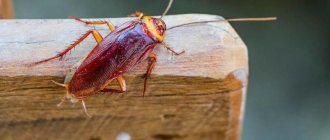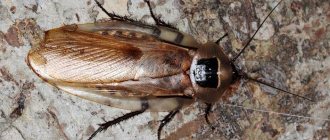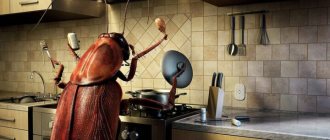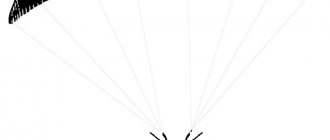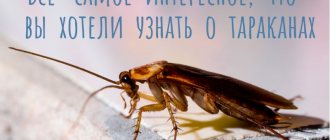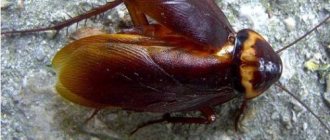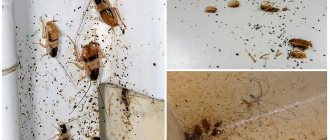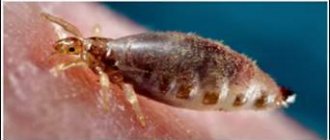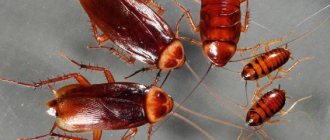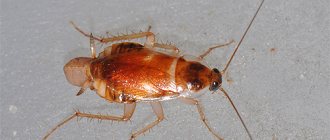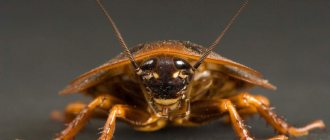Insects 08/06/202010888 views
Madagascar hissing cockroaches are a genus of cockroaches found exclusively in Madagascar. There are about 20 known species of hissing cockroaches; there are very big problems with the taxonomy of most, since it is not clear whether they are a whole species with variations in colors, or different species.
The most striking difference from most cockroaches is the absence of wings at all stages of development. Having excluded the ability to fly, nature gave these cockroaches a durable chitinous shell, as well as a characteristic shield on the cephalothorax, on which males grow horns. And, of course, do not forget about the size - some species can reach nine centimeters. The color of these insects varies from light red to almost black. As a rule, their nymphs are darker than adults and have a more dense build. It is quite easy to distinguish between males and females in most cases. Males, as mentioned earlier, have horns, which are the main difference. But some species lack these horns, making sex determination more difficult. Then you can focus on the last segments of the abdomen; in females they are wider than in males.
Keeping Madagascar cockroaches as pets
Few people know that the cockroach is a pet.
This seems disgusting from the perspective of anyone who enjoys snuggling with soft, furry animals. However, there are people who find cockroaches attractive; the pets don't mind people petting their fragile exoskeleton. Their simple nature and ease of keeping make them suitable for those new to exotic insect care.
Their behavior
Madagascar hissing cockroaches are dark reddish-brown to black, have a heavy exoskeleton and, unlike most cockroaches, do not have wings. They are one of Madagascar's 20 species of large cockroaches, many of which are kept as exotic pets.
They hiss when disturbed, and males hiss when courting. Sometimes an entire colony will hiss in unison for reasons we don't understand.
- A 10 to 50 liter aquarium or other container that will allow a group of 5 or more cockroaches to have room to move around.
- Cover so they don't run away. Although the insects are wingless, they are quite mobile and can climb up the sides of the container.
- Paper, sawdust or wood shavings (they don’t like cedar or pine), for bedding. It must be changed periodically, especially at high humidity levels.
- Build hiding places because insects do not like light; They will be happy with simple hiding places such as toilet paper cardboard bases, pieces of egg cartons, driftwood and small cardboard boxes. Cockroaches are more likely to exhibit aggressive behavior if there is an object in the cage.
- A container filled with water. The water should be kept in a shallow dish with cotton or some other absorbent material to prevent cockroaches from drowning. They will drink from the cloth. The water must be changed every week.
- Nutrition. Hissing cockroaches should eat a variety of fresh fruits and vegetables, including leafy greens (except iceberg lettuce) combined with a high-protein kibble food such as dry dog or mouse food.
Being tropical creatures, Madagascar cockroaches like to be kept just above room temperature of 75-90℉ (24-32℃).
Debbie Clark and Donna Shanklin, Entomologists
Parthenogenesis
Suriname cockroaches are unusual in that they reproduce using parthenogenesis, a form of reproduction in which embryos develop from unfertilized eggs. The offspring of Pycnoscelus surinamensis consists almost entirely of female clones.
Facultative parthenogenesis in conditions of isolation of females and males occurs in several species of cockroaches, including common synanthropes Blatta orientalis, Blattella germanica and Periplaneta americana, but for Pycnoscelus surinamensis parthenogenesis is the only method of reproduction. Previously, it was believed that Suriname cockroaches are capable of reproducing in both ways - both through parthenogenesis and with the participation of males in the reproduction of offspring.
Pycnoscelus surinamensis rarely gives birth to males: a few males were recorded in the observed Australian colony, and not a single male was recorded in the Florida colony in 15 years of study of the species. Their frequency of occurrence varies, suggesting that it is likely that the Australian colony adopted parthenogenesis later than the Florida colony.
In Pycnoscelus surinamensis there are at least 21 diploid clones born independently of females fertilized by males. This means a repeated transition from conventional reproduction with fertilization to parthenogenesis. There are also 11 triploid clones obtained by backcrossing between clones and individuals of the closely related species Pycnoscelus indicus. Throughout the species' range, the population consists of different clones: for example, in the United States alone there are ten populations of different clones.
Obligate parthenogenesis was only known in Pycnoscelus surinamensis until 2003, when it was discovered in Phyllodromica subaptera. Parthenogenetic representatives of Phyllodromica subaptera, distributed in most Mediterranean countries, are morphologically indistinguishable from representatives that reproduce by fertilization and are found only in the Iberian Peninsula, suggesting a recent acquisition of this feature.
Home maintenance
The reproduction and habitat of Madagascar cockroaches can occur at home. Breeding insects is very simple, even in the Russian Federation. The insectarium serves as the habitat of the house. Cockroaches do not smell, they are easy to keep and feed, and they take up little space. There is no need to walk an exotic insect either. In some cases, cockroaches are bred as food for lizards or tarantulas.
The terrarium must be equipped with:
- stone;
- snag;
- Each cockroach should have 1 liter of container volume.
For a couple of insects, you can take a small two-liter container. And for a family of 30, you will need a real aquarium of 30 liters.
How to make and decorate an eternal mini-terrarium from a light bulb?
Terrariums made from light bulbs look original and stylish. The most common light bulbs of different sizes are suitable for making such a terrarium. To begin with, we recommend trying to work with the largest light bulb.
You will need:
- Large light bulb;
- Screwdriver;
- Round nose pliers;
- Scissors;
- Long tweezers.
Be sure to protect your eyes with goggles, as pieces of glass may fly off during operation.
Step-by-step production:
- Remove the metal seal on the light bulb base.
- Then use a screwdriver to very carefully break the internal parts of the light bulb.
- Using long tweezers, remove the “entrails”.
- Finish the hole well with a screwdriver so that there are no sharp edges.
- To stabilize the light bulb, make legs by adding 2-4 drops of silicone glue.
- Now pour sand and dry moss through the funnel and place the plants using long tweezers.
- You can use small pebbles and plastic figures as decoration.
- A mini-terrarium made from a light bulb can be placed on a stand. This will make it even more impressive.
Mini terrarium in a light bulb
Reproduction of the Madagascar cockroach
The insect reproduces sexually. Life begins immediately after fertilization. The female carries all her offspring within herself and does not lay eggs or pupae.
Bearing offspring occurs in an unusual and original way. Fertilized eggs, glued together, form an oblong tube - an ooteca. The female carries such a capsule, a kind of apartment building, where a future cockroach develops in each compartment. It takes at least 2 months for the offspring to grow. Weather conditions and air temperature play a big role.
The female warms them inside her body, and if necessary, to “ventilate” the offspring, she simply pushes the ootheca through the anus. Once the time comes, the small cockroaches hatch into the female's body cavity. On average, the offspring number 30 young individuals (nymphs). Almost immediately they come out along with the remains of the ooteca.
While they are still “children,” the color of their shell is white, soft, and their eyes are black. Several hours will pass and the shell becomes darker and hardens. The female Madagascar cockroach shows care for the offspring, which is rarely seen in other insects. If she fears for the safety of the babies, she hisses in the hope of scaring away the danger.
The first few days after birth, the juveniles try to stay close to their mother, but as soon as they get used to it, they scatter to the sides. It is difficult for the younger generation, because they are growing disproportionately and need to shed their tight shell. About six times the cockroach will need to get out of the tight chitinous “shell”.
The seam of the shell cracks along the back and the grown nymph, pushing its halves apart, climbs out. The new body shell is quite soft, white and does not protect well from damage. But it doesn't last long. After molting, the nymph eats her old shell, and before she can handle it, her body will darken and the covering will harden.
The nymph will have its last molt approximately six months after birth. As soon as she sheds her shell for the sixth time, she enters adulthood, ready to mate and reproduce. You can determine that a “Madagascar” is about to molt by its behavior. A couple of days before the process, the insect leads a sedentary lifestyle, lethargic and tries to hide in a secluded place.
If you are able to provide normal care for cockroaches at home, then there is a chance that they will live with you for at least 5 years.
What to do if a lot of small black individuals appear in the apartment
Young insects are often much easier to kill than adults. This is due to the fact that pests at the initial stage of development are not yet covered with a hard shell. They shed periodically, and the cuticle becomes softer and more susceptible to negative external factors, including mechanical stress and chemicals.
Moreover, it is recommended to remove them before entering the adult stage. If this is not done, the small insects will mature, 1-1.5 weeks after the last molt, they will begin to mate and make new clutches.
Black cockroaches appear the same way as red ones.
Folk ways of getting rid of uninvited “guests”
Such methods are effective when fighting small groups of cockroaches that have managed to appear in a person’s home. They can no longer cope with many pests. However, traditional methods are also often used to prevent infection of an apartment. The most effective means at hand are presented in the table.
| Recipe | Active components | Estimated cost of the finished product, rub. |
| Boric acid (1-2 packets of 10 g) + bait (chicken egg) | An antiseptic is used in powder form. Any other product can be used as bait, which will lure insects out of their shelters | 20-30 |
| Alabaster + flour (take an arbitrary number of components, ratio – 1:1) | Alabaster hardens quickly when in contact with water, and the flour attracts insects. When young individuals try the poison, they will quickly die | 70 |
| Method of cooling the room: in winter, open all windows, first turn off the heating system. When the temperature drops to 0°C, cockroaches die | – |
Folk remedy for fighting cockroaches
We poison with chemicals
If there are quite a lot of small cockroaches at home, then you can no longer use improvised means. More effective insecticide-based preparations will be needed:
- Battalion commander This is an aerosol containing 2 active substances (pyrethroid class). When spraying, you can get rid of insects that cannot be seen - they are located in small crevices. Treatment of such areas is carried out thanks to a thin nozzle, which comes complete with the cylinder.
- Raptor. This is another pyrethroid-based aerosol product. This class of insecticides includes nerve agents. The product is odorless and contains an amplifier of the main toxic substances.
- Clean house. Release form: powder. The composition includes insecticides of the pyrethrodia group (2 different substances) and organophosphate. This increases the efficiency of treatment and prevents the development of resistance.
- Karbofos – concentrate. Contains malathion, a substance of the organophosphate class, characterized by a prolonged action.
- Mashenka. This drug is in solid form (pencil), inexpensive, easy to use, but does not last long. It is used for barrier protection at home.
Some examples of aerosols for controlling cockroaches
Safety rules when processing at home. Pregnant women, children, pets
When insecticide-based products are used, there is a risk of poisoning, since toxic substances are released into the air and remain on all surfaces, objects, and things. To protect yourself from danger, adhere to the following rules:
- processing is carried out in masks, and even better - in respirators;
- when working with liquid concentrates and aerosols, wear closed clothing and a hat so that as little poison as possible gets on the body;
- all procedures are performed with rubber gloves;
- after finishing work you need to take a shower;
- The mouth and eyes should be rinsed with water.
They are not allowed in until the floor has been washed and the main surfaces have been cleared of poison. The procedure for treating a room against insects should not be carried out by pregnant women.
Sanitation of the premises
We combine methods of influencing adults, larvae and their eggs
The most effective method of destroying pests at any stage of development is combined treatment. In this case, various types of drugs and folk remedies are used simultaneously or sequentially. But not all of them destroy cockroach eggs. To prevent the appearance of offspring from ootheca, a steam generator is additionally used.
Types of professional steam generators
Madagascar hissing cockroach, breeding at home
Feeding insects, Cockroaches
Madagascar cockroach description:
Madagascar cockroaches are one of the most popular food items, and simply pets, for a number of reasons: ease of maintenance, large size of cockroaches, good fertility, and availability in almost all cities, they are often sold even in pet stores, which cannot be said about other large cockroaches sizes.
As you might guess, the homeland of the cockroach is the island of Madagascar, where cockroaches swarm in fallen leaves and on tree trunks in search of food. Many novice keepers of this species claim that it is necessary to create living conditions close to natural, right down to the substrate at the bottom, and a nighttime drop in temperature. Let's see if this is true.
Characteristics of the Madagascar cockroach:
Size: Females are slightly larger than males up to 7.5 centimeters, males 6.5 centimeters
Presence of wings: No, but they jump from small heights very successfully.
Lifespan: Up to 2 years or more.
Development: 1.5 years to an adult, sexually mature cockroach.
Birth: Viviparous.
Development of ootheca: 2-3 months after fertilization.
Crawling on glass: Yes.
Features: They can hiss to scare away enemies by releasing air from the breathing holes.
Contents of the Madagascar cockroach:
Many people recommend keeping Madagascar cockroaches on sawdust, or coconut substrate, or even on fallen leaves, this is possible, but with a large number of cockroaches, this is very problematic in terms of hygiene and cleaning. Therefore, it is recommended to keep Madagascar cockroaches on egg trays, like many others.
The temperature of the keeping is also not much different, from other cockroaches it is 25-29 degrees, you can additionally warm it with a lamp or other means.
Madagascar cockroaches have increased requirements for humidity: 60-70%, this can be achieved by installing a container with water or a damp substrate, or you can spray it once every few days.
An old aquarium or a plastic container with smooth walls and a tight lid may be suitable as an insectarium for Madagascar cockroaches. The planting density of cockroaches is indicated differently in different sources; you can take it at the rate of 1 liter per 1 adult cockroach.
Feeding the Madagascar cockroach:
Feeding for Madagascar cockroaches is standard, as for any others; oatmeal, bran, and succulent foods such as carrots, apples, and pears are ideal. Some resources recommend feeding them chocolate; I would refrain from such experiments.
Reproduction of the Madagascar cockroach:
Reproduction is not a complicated process; all you need is literally 2 cockroaches of different sexes and a little patience. At low temperatures the process may take longer. Males in the battle for a female can engage in fights and bite off each other’s antennae. Males differ from females, firstly, in their smaller size, and secondly, males have small horns on their heads, but females do not.
Home » Forage insects » Madagascar hissing cockroach breeding at home
Preventive measures
As preventive measures against the spread of cockroaches in the home, it is recommended to use the following recommendations:
- Maintain perfect cleanliness in the kitchen and in the apartment as a whole. There should be no crumbs on the tables and floors, and greasy deposits on the walls. The trash can should be taken out in a timely manner, without putting it off until tomorrow.
- Store seasonings in glass, hermetically sealed containers.
- Wash dishes and sinks promptly.
- Do not leave containers with prepared food or grocery bags open.
- Cover the air vents with a grill or fine mesh.
- Cockroaches can live for several weeks without a head, which has been confirmed by repeated experiments.
- Many species can fly (the synanthropic American or Lapland cockroach).
- Whiskered insects may not breathe for 40 minutes. This property contributes to the retention of water available in the body when it is impossible to replenish it.
Shedding
Molting of a Madagascar cockroach
Madagascar cockroaches tend to shed, but they shed not their fur, but their shell. In the intervals, the nymphs grow up. The surface cover has 10 segmental armored areas, articulated with each other by softer tissue. A breakthrough forms along the back, involving the three initial segments. New, not yet formed chitin peeks through the hole. Gradually the crack grows, bending the cockroach's back. The new body thus begins to protrude outward. Then a head with black markings-eyes appears. Only at this time can you look at them carefully. Usually they are hidden. Whiskers and paws extend later.
The abdomen remains in the shell the longest. Before the last jerk, the cockroach takes a break. The hatched body looks unnaturally elongated, with rounded proportions. 30 minutes after the completion of molting, the appearance of the insect changes: the peritoneum is retracted, intersegmental folds are smoothed out, and the body is shortened. It expands and becomes flat. The entire procedure takes about 40 minutes.
After molting, cockroaches begin to eat the shed shell. Thus, they strengthen the new shell. The color changes before our eyes: first it acquires a grayish tint, then dark brown. The next day, the moulted individual is no longer different from the others.
Reproduction of Madagascar cockroaches
Cockroach reproduction differs in that the eggs are hatched inside the body. After fertilization, the laid eggs stick together and form a separate compartment - an ootheca. Throughout the entire period of egg development (50-70 days), the ootheca is located in the abdomen. Sometimes the female lets it outside for ventilation.
Ootheca of the Madagascar cockroach
The warmer the climatic conditions, the shorter the gestation period. The nymphs are released from the eggs inside the female and are immediately squeezed out along with the remains of the ooteca. Newborn cockroaches are several millimeters in length and white in color. The first hours feed on the remnants of the ootheca, gradually turning into a natural color. The female vigilantly guards her brood, preventing them from scattering and protecting them from potential danger. The female gives birth to up to 25 larvae at a time. They stay near their mother for several days, then leave their inhabited territory.
Before puberty, nymphs molt up to 5-6 times. The shell cannot increase, so it cracks as the insides grow. The old shell is squeezed out of the hole. Eating it, the insects gradually darken. Their new covering is hardening again. The duration of this period depends on environmental conditions, on average it is 6-12 months.
Lifestyle
In the wild they live on tree trunks and large bushes. They hide during the day and intensify their activity in the evening. They feed on vegetation and fruits. Life expectancy in the wild is no more than 2 years. In captivity, insects live on average 3 years, but there are long-livers - 6 years.
The Madagascar cockroach hisses. The formation of sound occurs due to a sharp contraction of the abdomen and the passage of air through the spiracles. Males hiss when fighting with rivals to attract females; females in this way notify of danger.
Possible dangers to humans
Anyone who wants to have such a bug needs to know the basics of its behavior, character and characteristics. They do not bite or attack people, but there is still one “but”, they know how to stand up for themselves. If he senses danger to his life or to his offspring, he is capable of biting only in self-defense. This does not happen suddenly, it initially warns with a hiss or whistle. If it so happens that you didn’t believe in his warning signs and a bite happened, don’t worry, nothing will happen to you. It is enough to disinfect the bite site.
Regarding infections and unpleasant smells, this can only happen through the fault of the owner. If you do not remove leftover food, do not change the bedding and water, then sooner or later rot and mold will appear, which will contribute to the development of infection. In this case, insects have nothing to do with this problem. You should not have any pets for the sake of fashion or photography.
Platypus
The platypus (Ornithorhynchus anatinus) lives in streams, ponds and rivers in Australia. These animals usually reach a length of 30–40 centimeters and weigh about 2 kilograms.
The unusual thing about the platypus is that it combines the features of mammals, birds, reptiles and even fish. Looking at it, you won’t immediately understand whether it’s a bird or some kind of animal... In fact, these creatures are mammals, although they lay eggs. The platypus is a bit like a beaver, but with a soft beak covered with elastic skin, which is not found in any other animal. Underwater, the platypus closes its eyes and uses its beak, with which it senses weak electrical impulses emanating from its prey. Using its beak, the platypus digs through the mud in search of small fish, frogs and insects. Scientists are still arguing about the origin of this species, but only one thing is clear - this is a unique creation of Mother Nature, which differs from all other species currently living on planet Earth.
Male platypuses have poisonous spurs on their hind legs. The animal's venom is unlikely to kill a person, but it causes severe pain at the injection site. But for small animals this poison is often fatal.
What can the Madagascar cockroach do?
At first glance, a cockroach looks quite scary even for an adult, but after meeting this funny creature, it becomes clear why they love it.
- Despite the lack of wings, the insect can jump perfectly from a small height.
- The cockroach is a good runner, so it has long been a participant in numerous races, which are considered fashionable entertainment in many countries.
- They can emit a loud hissing sound similar to a snake's. An insect does this at a time of danger, during mating or courtship. The hissing, sometimes turning into a whistle, looks quite funny.
- He has a calm character, so handling him is interesting not only for adults, but also for kids.
Lifespan
After 50-70 days, larvae appear, which are called nymphs. First of all, the nymphs eat the remains of the ooteca. This is their first food. The nymphs stay near their mother for several days, and then crawl away. Up to 40 cubs can appear in one litter, but not all survive. To become an adult, a nymph goes through 6 molts.
The life cycle of the Madagascar effervescent cockroach is long and different from most other cockroaches. Females give birth to live individuals. They carry the newborn nymphs for approximately 60 days until they emerge as first stage impons. One female can produce 30-60 nymphs.
This insect has an incomplete life cycle: eggs, nymphs, adulthood. Nymphs and adults are wingless and live from 2 to 5 years.
Behavior, nutrition, habits
They hiss when they are worried or alarmed. The sound is produced when air is forced out of the gap in the abdomen. The hissing is very loud and plays an important role in the hierarchy of colonies, courtship, and communication.
It is used to communicate with the rest of the colony, as well as to threaten and warn off predators. Males are particularly aggressive, remaining in their colonies for several months to protect them from harm.
Madagascar cockroaches are not picky eaters. They can be fed fruits and vegetables. Cockroaches even eat porridge and boiled eggs. They especially love bananas, apples and carrots. They need calcium to strengthen their shell. But feeding cockroaches with dog and cat food is not recommended. Additionally, in the terrarium you can organize a drinking bowl in the form of a sponge soaked in water, but placing a container with water is strictly prohibited. Cockroaches will definitely drown in it. There must be food in the terrarium all the time, otherwise the insects will eat each other.
Mating process
Reproduction of Madagascar cockroaches begins in the spring. Males hiss and whistle to attract a female. If several males claim a female, then battles between rivals occur.
They push with their bellies, trying to push the enemy as far as possible. Cockroaches fight with projections on the head shield and bite off each other's antennae. The winner gets the female.
It is recommended to place coconut substrate in a container with a pregnant female. It retains moisture well. Under comfortable conditions, cubs appear 55 days after mating and fertilization.
If the microclimate in the terrarium does not correspond to the norm, then the development of embryos is delayed. Pregnancy can last up to 77 days.
When the young are fully developed, they gnaw through the ootheca. The female Madagascar cockroach opens the genital slit in the abdomen and releases the young. She tenses her abdominal muscles, pushing out the babies.
Why do people keep large insects at home?
There are two types of owners of the Madagascar cockroach, the first one keeps it as a pet, the second one keeps it as food for its pet. They often become food for spiders and lizards, parrots and crows; it is quite expensive to buy such food for your pets; it is much cheaper to breed it yourself at home.
Regarding those who keep them as pets, there is nothing strange or scary about this. Many can condemn, twist at their temples and say how crazy this idea is, and here you can argue with such people endlessly.
- The first argument in favor is that it is an exotic pet; after all, they have spiders, lizards, and snakes, then why are cockroaches so scary? They are much safer and nicer.
- The second is easy care. Not everyone can afford to walk their dog at least 2 times a day. Many people go on business trips, and then there can be no talk about pets at all, but that’s what they want.
- The third is love for animals. Where is it written that you can only love fluffy and cute animals? If a person is ready to create ideal living conditions and share his love and care, then why condemn it.
Zoo "Cobra Mobras"
ETNOMIR, Kaluga region, Borovsky district, Petrovo village
The “Cobra-mobra” zoo is located in the ethnographic park-museum “ETNOMIR” between the husky nursery and the EthnoFarm. From the western end of the hut, charming and always positive meerkats greet guests through the window. Inside there are about 30 species of large invertebrates and small vertebrates from all over the world. Animals are specially selected and prepared for safe contact with people. Guests interact with the zoo’s pets during the unique one-hour program “Give a Paw to a Friend.” The program is hosted by Andrey Zatoka, a zoologist with 40 years of experience in scientific and educational activities. The program is full of interesting facts, and guests will learn a lot of new things both about exotic pets from distant countries and about ordinary representatives of our fauna. The program is designed for families with children over 3 years old, and is also popular among school groups of up to 20 people. As elsewhere in ETNOMIR, photography and video shooting are allowed, and guests can take impressive pictures as a souvenir.
General characteristics of the Madagascar hissing cockroach.
Madagascar cockroaches are classified as tropical insects due to their natural habitat. This type of insect is more common under the name Madagascar hissing cockroach. The insects received this name due to the special hissing sound that they make under certain conditions. These conditions include the period of courtship or situations when they were disturbed.
Adults reach 9 cm in length, and usually weigh no more than 60 g. They have a durable shell, the color of which, depending on the subspecies, may vary slightly and is in shades of brown, from light brown to almost black. Madagascar cockroaches do not have wings. They can move even on very slippery surfaces. This became possible due to the pads that are located on the legs of insects. You can buy Madagascar hissing cockroaches in specialized zoological stores and salons. Not every ordinary pet supply store can afford to sell such a curiosity. The cost of these exotic insects is not high, if you look at the cost of one individual. But to equip a full-fledged colony, you need to buy about 30 insects. The relatively low price of insects is compensated by the high budget for their maintenance. The nature of insects is calm and, contrary to many misconceptions that they can be dangerous to humans, they can only cause an allergic reaction. However, it is extremely rare.Distinctive appearance features
The Madagascar hissing cockroaches include a whole group of cockroaches whose habitat is Madagascar. This island is their natural homeland; in other countries they live only in the cages of lovers of exotic creatures, sometimes they are brought in boxes of bananas.
In total, entomological specialists identify 20 species of such cockroaches, but they have not been able to definitively determine the groups and characteristics for differentiation.
The most typical distinguishing features of insects include: a dense body on which there are no wings (they are absent in both small and adult individuals). In many other cockroaches, mature representatives of the species have wings (only the larvae may not have them), and some species have even adapted well to flying.
The breeders and owners of “Madagascars” themselves claim that nymphs in the last stages of development are very similar to adult individuals, sometimes it is not even possible to distinguish them.
As for the appearance of insects, it is quite recognizable: cockroaches have a massive and wide body, and there is a pronounced chitinous shield on their cephalothorax. The size of adult Magascars can be quite impressive - some individuals reach even 9 cm in length. If a person takes his inhabitant in the palm of his hand, he will occupy it almost completely.
The color of the outer shell of cockroaches is not uniform. The abdomen can be light red, rich rusty, brown or even almost black. More often, adult insects are distinguished by a darker color and a dense body. The appearance of the larva is strikingly different: the chitinous shell is light, the relief is clearly visible.
Adult Madagascar cockroaches have one specific physiological feature: small outgrowths located on top of the chest plate, similar to small horns. They are present only in male cockroaches; thanks to these processes, in some species it is possible to determine males or females. In females, the head is flatter, almost merging with the rest of the body.
However, there are varieties of Madagascar hissing cockroaches in which the males do not have very prominent projections on their heads. In this case, it is not possible to determine where the female is and where the male is. If separation is necessary, they are guided by other signs:
- what condition are the whiskers in: in male cockroaches they are usually damaged (broken), since individuals use them when they try to defend their right to a female over competitors. Females do not participate in such battles, so their mustaches are smooth, beautiful and intact;
- along the two extreme sections of the abdomen: in males the very edge of the body is black, while in females the last 2 segments are usually dark. In addition, due to the reproductive function, the abdomen of females is slightly wider. If you put two cockroaches of different sexes next to each other, the differences will be very clearly visible.
It is noteworthy that sex determination is only appropriate for imagoes. Nymphs do not have obvious characteristics by which individuals could be differentiated. Despite the fact that almost sexually mature individuals resemble adults, their cephalothorax is not yet so well developed.
What is the purpose of maintaining a house?
A pet is considered ideal for those who appreciate the exotic, so its unpretentious keeping is suitable for such people. First of all, it is better to get one for those who do not have an aversion to insects, but like to have fun with them. For several years, the cockroach will delight its owners.
Cockroaches do not bite and do not carry infectious diseases, so they can be safely bred by a family raising a small child. An excellent advantage is the cleanliness of the insect and the absence of odor from it. For those who love cleanliness and order, the Madagascar cockroach is more suitable than other pets that are usually kept in the house.
Lovers of dietary dishes and natural protein foods can breed cockroaches for themselves to use as food. There are special recipes for cooking insects.
How do Madagascar cockroaches reproduce?
Insects are viviparous. Pregnancy can last about two months, it depends on the temperature in the terrarium, so the necessary regime should be maintained. An ootheca (chamber) forms inside the female, where there are eggs in which larvae form. The swelling has a solid structure. At the end of pregnancy, the larvae emerge from the female’s abdomen along with swelling.
Once born, the larvae reach a length of several millimeters and are covered with a soft white shell. After a few hours, the shell darkens, and the larvae become similar to their mother. At one time, about 30 little Madagascars can be born, which will only stay next to the female for a few days, and then crawl away to the sides.
Adults do not eat small larvae, so all cockroaches can be kept together. Nymphs grow inside their chitinous shell, which, as they grow, cracks several times on the back and slides off. The crawling small individual is light at first, but quickly darkens, eating its old shell. You should know that the growing period for cockroaches ranges from six months to a year, this also depends on the quality of food. In order for them to grow faster, they need high-quality and varied food.
Sometimes you can notice that some cockroaches do not show activity, they can roll over on their backs and kick their legs. Some parts of the legs may even fall off. You can also notice that the end of the abdomen is covered with a white coating. This indicates an insect illness.
A cozy home for your pet
For Madagascar cockroaches, a plastic aquarium at home is suitable as a home. Its volume is determined from the following standards - one liter of space per individual. The presence of handles and light weight will allow the owner to take the insectarium with him. For example, to participate in exhibitions or organize long-distance moves.
The presence of ventilation holes allows you to keep adult individuals or young animals older than four months in such aquariums. Cockroaches that have just been born can be kept in ordinary jars with a volume of three to five liters. The lid will be gauze secured to the neck with an elastic band.
Drinking bowl
Cockroaches from Madagascar require constant access to water. Just don’t just put a container of water in the terrarium (like the one given to decorative rabbits) - the insects will simply drown in it, especially if there are a lot of young animals in the colony. The best solution to this problem would be a special drinking bowl, which can be easily done at home. Take a small piece of material similar to a sponge or foam rubber, place it in a shallow container and regularly moisten it with water.
Specific features, characteristic only of this type of cockroach, make it possible to distinguish it from a wide range of relatives and attract human attention. For example, a female insect is viviparous, that is, she does not lay eggs (which is what the inhabitants of average kitchens do)
The hatching larvae spread throughout the terrarium at an impressive speed. It will take them about four months to achieve external resemblance to their parents. One clutch contains from 10 to 50 larvae.
Litter
To create comfortable conditions, it is recommended to cover the bottom of the container:
- sawdust,
- shredded sheets of clean writing paper,
- coconut substrate,
- clay mixed with sand,
- small pebbles.
Small pressed sawdust, which is often used for cat litter, is also suitable. What layer height to choose is a matter of personal preference of the owner. The same applies to the presence or absence of bedding, since it does not have any effect on the health of the cockroach.
If the owner decides that his Madagascar cockroach needs bedding, he should remember not to use sawdust from coniferous trees, especially if it is cedar. The frequency of substrate change is determined by the number of individuals and cell size. As a rule, the average is once a month.
Individual "houses"
Endemic to the island of Madagascar, they are nocturnal by nature. In their homeland during the day they hide under stones and leaves. At home, cylinders that are hollow inside will serve as shelter, which can be connected to each other to form various structures. Egg cages can also be an option – breeders often use them to build small houses that increase the usable area of the cage.
Pieces of pine bark, as well as clay figurines intended for fish, provide excellent shelter.
Temperature and humidity
Comfortable temperature indicators are 25-30°C. Lower numbers make cockroaches passive and reduce the likelihood of having offspring. Humidity is also of great importance - about 65%. Spraying the walls of the terrarium with plain water several times a week helps maintain it. A regular sprayer is suitable for these purposes.
Distribution area
The American cockroach is widespread in its homeland - Africa and the countries of North and South America. Recently, it has become increasingly noticed in Europe, but in Russia it has been replaced by the Prussian, which is more adapted to life in urban conditions. In this regard, the large size and large number of offspring played a bad joke on the American immigrant.
In order to feed numerous voracious offspring, you will need supplies larger than those stored in an ordinary typical apartment, and the harsh climate of mid-latitudes does not allow you to settle in garbage cans, always full of food. And it’s much more difficult for a big American to hide than for a Prussian midget.
As a rule, insects of this species inhabit large heated industrial buildings with an extensive ventilation system, sewers, and food plants. In their homeland, they settle not far from human habitation, feeding on the remains of civilization waste.
Why do people keep Madagascar hissing cockroaches?
Food can be either fresh or rotten. Insects often eat the corpses of relatives. In order for the shell to be strong, the diet must include foods containing large amounts of calcium.
This is especially important for young animals and during the mating season.
A colony of 30 individuals is freely located in a terrarium measuring 20x30x40 cm. The insect has soft pads on its legs, which allows it to move freely even on a completely smooth surface. This obliges the owners to close the container with the colony tightly enough. Air access is provided through small holes.
Even if the individual manages to somehow leave the terrarium, the owner should not worry. Keeping such a specific pet at home is possible due to its calm nature, without displays of aggression. Therefore, the presence of the insect is allowed even in those families where there are small children. There is only one limitation - if someone in the household has allergies.
Male and female have some external differences
Externally, it is not difficult to distinguish individuals of the Madagascar cockroach. Nature endowed males with two raised horns located on the prothorax. Another sign is the larger size of the antennae when compared with the length of this part of the body in females.
Having such an unassuming pet at home is quite interesting. Suitable conditions and good nutrition will make the life of the insects fulfilling, and you will receive a good income by selling the excess individuals.
Madagascar cockroaches are harmless insects. They are not capable of harming a person, much less biting him. They do not emit any unpleasant odors. The hissing of insects may unnerve some people at first, but owners quickly get used to it and even begin to get bored when cockroaches are silent.
Keeping insects at home is interesting and exciting. Some owners organize exciting cockroach races. Others simply admire them, enjoying their presence in the house. The Madagascar cockroach often brings in quite a bit of income.
Gymnur
Gymnurs (lat. Galericinae) are the closest relatives of the prickly hedgehogs familiar to us, but their appearance is not at all like that of a hedgehog. These strange creatures are more reminiscent of possums, shrews or rats, but they are enormous in size - up to 45 centimeters in length, and a few tens of centimeters more on their hairless, rat-like tail. Gymnur even has a middle name - moon rat. But the most important thing is that they have no thorns at all!
Moon rats live in the tropical rainforests of Malaysia, the Philippines and Indonesia. If ordinary hedgehogs use spines as protection from enemies, then the gymnur is more original here: near the base of the moonrat’s tail there are glands that secrete a liquid with a strong unpleasant odor. They say that the animal smells very strongly of onions!
Reproduction
The Madagascar reproduces by viviparity. After fertilization, the female bears future offspring in a special chamber - the ooteca. Egg development lasts for 50-70 days, depending on air temperature. The colder the climatic conditions, the longer the female will carry the so-called pregnancy.
The nymphs leave the eggs while still in the female’s body cavity, and then come out along with the ooteca. The larvae eat the ootheca within a few hours and quickly change their original white color to dark. As a rule, one cockroach brood contains about 25 larvae. After birth, they stay near the mother for 3-4 days, after which they spread out in different directions.
Madagascar breeds by viviparity
During the period of maturation, the nymph molts several times. The chitinous cover does not grow with it. When the time comes, the shell splits on the back, then moves apart, and a grown nymph emerges from it. Its new shell is light and soft, but during the period during which the nymph eats its previous shell, the new shell becomes hard and the insect acquires its normal color.
The duration of the developmental stage from birth to the last molt is directly dependent on external conditions, nutrition and varies from 6 months to 1 year. During all this time, the nymph molts 6 times.
Okapi
The okapi (Ornithorhynchus anatinus), or forest giraffe, lives in the forests of the Congo. This animal is very rare, and the story of its discovery is one of the most notorious zoological sensations of the 20th century.
There is a sad donkey in front, a zebra in the back, and overall a forest giraffe. Okapi has such a long (up to 35 cm) tongue that it can clean its ears with it. The coloring is also very unusual: the body is reddish-brown, the legs are white with dark transverse stripes on the thighs; the tail ends in a tassel.
Zebu
Zebu (Bos taurus indicus) is a humpbacked bull native to Southeast Asia. This is the most ancient and mysterious representative of bovid ungulates. Scientists around the world are puzzling over its origin. The unusual animal has a high, prominent hump on its back and short, widely spaced horns.
The health of humpbacked bulls is excellent: they easily tolerate diseases that kill cattle of other breeds. Domesticated zebu are mainly used as draft and pack animals, and in some places in Southeast Asia, zebu racing is very popular. Of course, a humpbacked bull is not nearly as graceful as a thoroughbred horse, but it can compete with any racer.
Molting of the Madagascar cockroach (video)
In some cases, insects are fed:
- salad;
- dandelion;
- celery;
- cabbage
You can give the cockroaches cat food, cookies, and corn sticks. The main thing is that the products are dry. In order for the insect's shell to be normal, the pet should be fed foods containing calcium.
It is important that the cockroach has access to moisture. If there is no fresh fruit and water, he dies
However, you cannot install a regular drinking bowl for rodents. Cockroaches can simply drown in a bowl. The ideal option is a piece of foam rubber moistened with water. Insects will drink while crawling on it. The foam will have to be wetted periodically.
Requirements for keeping in captivity
You need to know what to feed insects. The source of life is water, which cockroaches get from fruits. Breeding in captivity presupposes the need to provide a safe watering area where pets cannot drown. It is necessary to include fruits in your diet. In addition, the cockroach should receive cereals (buckwheat, oatmeal) and dry fish food. You need to give the insects leaves of cabbage, lettuce, dandelions, and also boiled eggs.
If you plan to keep Madagascar cockroaches, their maintenance requires a careful approach:
- The humidity level is within 65%, for which the insects’ home is periodically sprayed with water and containers with liquid are installed;
- The air temperature should not go beyond +18...+30 degrees;
- Ventilation holes are made in the aquarium with a lid.
The main thing is that food is constantly in their cage and is varied, otherwise insects may exhibit cannibalism
Features of the terrarium
The first step, which involves keeping Turkmen cockroaches, is purchasing a terrarium. From the very beginning of breeding, you can get by with a glass container or some kind of plastic container. To ensure that insects have a sufficient amount of air in the lid of their home, it is necessary to make small holes, or the container can be covered with a metal mesh with small cells.
The substrate in the terrarium is shavings and sawdust. To significantly increase the living area, you need to place branches or empty egg trays in your home. Such decorations will be very useful for young individuals during the molting period. Experienced experts say that the Turkmen cockroach molts in a vertical position of its body, with its head down. The process of molting on a horizontal surface can cause injury to insects, and the presence of simple devices will protect cockroaches during the change of chitinous cover.
We should not forget about the presence of a feeder and drinker in the terrarium. To prevent Turkmen cockroaches from harming themselves and choking, you need to put foam rubber or substrate at the bottom of the drinking bowl. Sometimes breeders use test tubes filled with cotton wool and water.
Insects do not require high levels of humidity, so there is no need for irrigation. Low temperatures can slow down the development of young animals, so it is best to ensure temperatures in the terrarium of +27 - +30 degrees.
